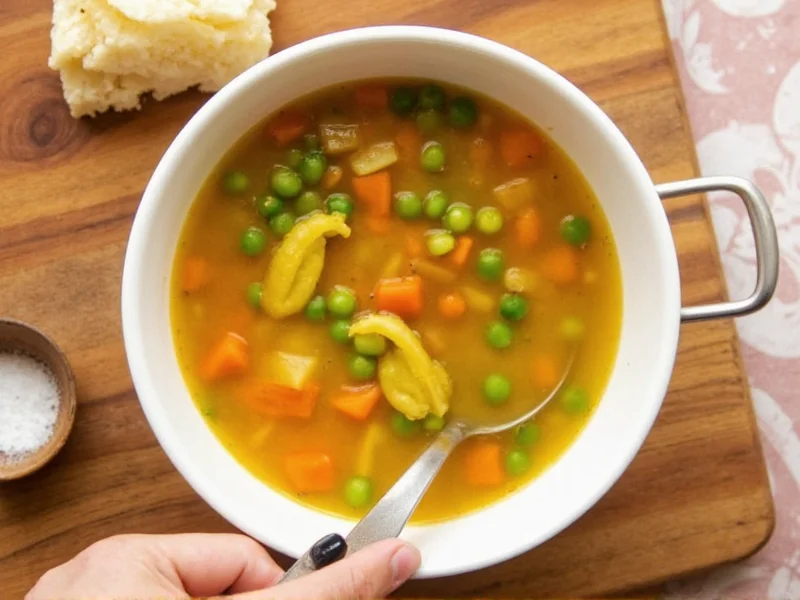Essential Ingredients for Perfect Vegetable Soup
Creating a flavorful vegetable soup starts with selecting quality ingredients. The foundation of any good vegetable soup includes:
| Core Ingredients | Quantity | Preparation Tips |
|---|---|---|
| Olive oil | 2 tablespoons | Use extra virgin for best flavor |
| Yellow onion | 1 medium | Diced evenly for consistent cooking |
| Carrots | 2 medium | Peeled and cut into 1/4-inch rounds |
| Celery | 2 stalks | Finely chopped including leaves |
| Garlic | 3 cloves | Minced finely |
Step-by-Step Vegetable Soup Preparation
Follow these professional kitchen techniques to create a vegetable soup with deep, complex flavors. Many home cooks rush the initial sauté step, but taking time to properly cook the aromatic base (known as mirepoix) makes a dramatic difference in your homemade vegetable soup from scratch.
Building Flavor Foundations
- Heat olive oil in a large pot over medium heat until shimmering but not smoking
- Add onions, carrots, and celery; cook for 8-10 minutes until vegetables soften but don't brown
- Stir in minced garlic and cook for 1 minute until fragrant
- Add 1 tablespoon tomato paste and cook for 2 minutes to deepen flavor
Adding Vegetables and Liquid
For the best quick vegetable soup for beginners, add vegetables in stages based on cooking time:
- First add harder vegetables like potatoes and turnips (cook 10 minutes)
- Then add medium-cook vegetables like green beans and zucchini (cook 8 minutes)
- Finally add quick-cook vegetables like peas and spinach (cook 3-5 minutes)
Pro Tips for Restaurant-Quality Vegetable Soup
Transform your easy vegetable soup recipe from good to exceptional with these chef-tested techniques:
Flavor Enhancement Methods
- Acid balance: Finish with 1-2 tablespoons of lemon juice or apple cider vinegar to brighten flavors
- Umami boost: Add 1-2 dried shiitake mushrooms while simmering for depth
- Herb infusion: Tie fresh thyme, parsley stems, and a bay leaf in cheesecloth for easy removal
- Texture contrast: Reserve some diced vegetables to add in the last 5 minutes for varied texture
Customizing Your Vegetable Soup
One reason vegetable soup remains popular is its incredible versatility. Try these healthy vegetable soup variations based on seasonal availability or dietary needs:
Seasonal Adaptations
- Spring: Asparagus, fresh peas, and baby carrots with dill
- Summer: Tomatoes, zucchini, and fresh basil with white beans
- Fall: Butternut squash, sweet potatoes, and kale with sage
- Winter: Root vegetables, cabbage, and lentils with rosemary
Storage and Reheating Guidelines
Proper storage ensures your vegetable soup keeps well for future meals. Follow these food safety guidelines:
- Cool soup completely before storing (within 2 hours of cooking)
- Store in airtight containers for up to 5 days in the refrigerator
- Freeze in portion-sized containers for up to 3 months
- Reheat gently on stove over medium-low heat, adding broth if too thick
Common Vegetable Soup Mistakes to Avoid
Even experienced cooks make these errors when preparing vegetable soup from scratch:
- Overcooking vegetables until they lose texture and nutrients
- Adding salt too early, which can draw out moisture from vegetables
- Using low-quality broth as the base (homemade or high-quality store-bought works best)
- Crowding the pot during the initial sauté step, causing vegetables to steam instead of brown
Nutritional Benefits of Homemade Vegetable Soup
A well-prepared healthy homemade vegetable soup delivers significant nutritional advantages over store-bought versions. By controlling ingredients, you create a meal rich in vitamins, minerals, and fiber while avoiding excess sodium and preservatives. A typical serving provides:
- Multiple servings of vegetables in one bowl
- Hydration from the broth base
- Dietary fiber from whole vegetables
- Customizable protein options (beans, lentils, or tofu)
Frequently Asked Questions
How can I thicken vegetable soup without using flour?
Blend 1-2 cups of the cooked soup until smooth, then return it to the pot. Alternatively, mash some potatoes or white beans directly in the soup. Roasted cauliflower puree also creates a creamy texture without altering flavor significantly.
What's the best way to freeze vegetable soup?
Cool the soup completely, then portion into freezer-safe containers leaving 1-inch headspace for expansion. For best results, freeze flat in heavy-duty freezer bags. Properly stored, vegetable soup maintains best quality for 2-3 months. Avoid freezing soups with potatoes as they become grainy when thawed.
Which vegetables should I add last to prevent overcooking?
Delicate vegetables like spinach, kale, peas, and fresh herbs should be added during the last 5-7 minutes of cooking. Zucchini and summer squash also benefit from later addition to maintain texture. Harder vegetables like carrots, potatoes, and turnips need 20-25 minutes to become tender.
Can I make vegetable soup without broth?
Yes, you can create flavorful vegetable soup using water plus additional vegetables like mushrooms, tomatoes, and onions for depth. Add 1-2 tablespoons of nutritional yeast for umami flavor, or include a Parmesan rind while simmering. The key is building flavor through proper sautéing of the aromatic base before adding liquid.
How do I prevent my vegetable soup from becoming too watery?
Reduce liquid by simmering uncovered for 10-15 minutes to concentrate flavors. Alternatively, create a slurry with 1 tablespoon cornstarch mixed with 2 tablespoons cold water, then stir into simmering soup. For a more natural thickener, blend some cooked vegetables and return them to the pot. Remember that soups often thicken slightly as they cool.











 浙公网安备
33010002000092号
浙公网安备
33010002000092号 浙B2-20120091-4
浙B2-20120091-4